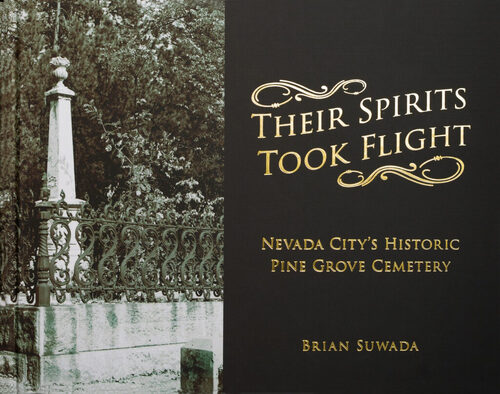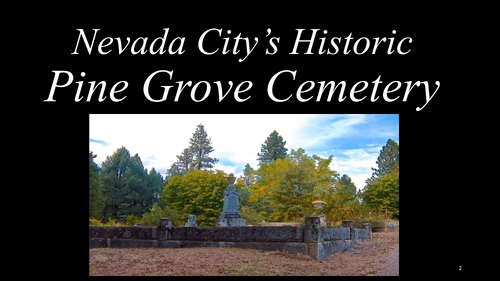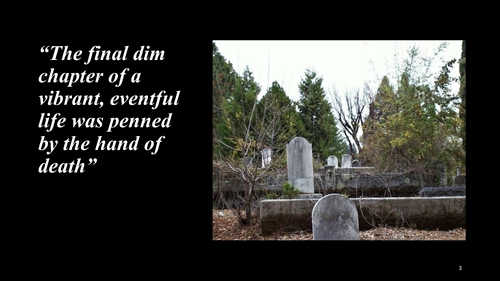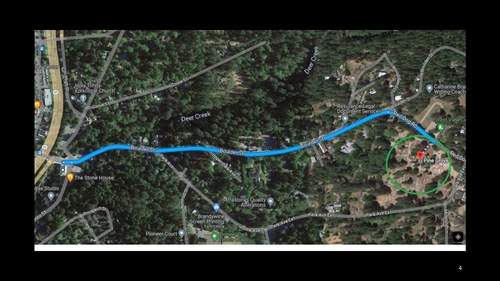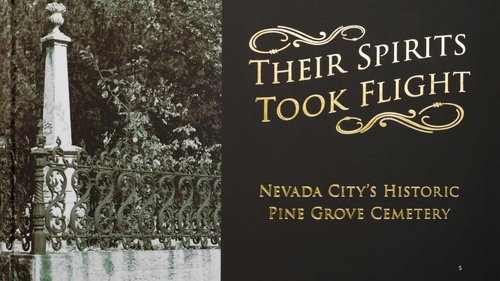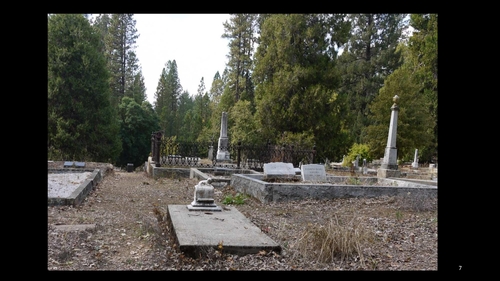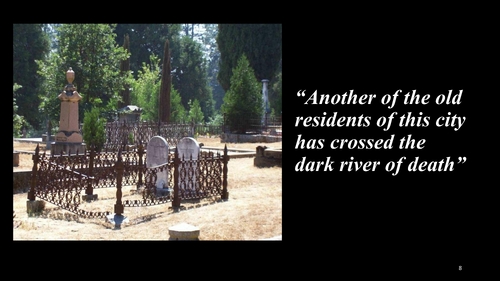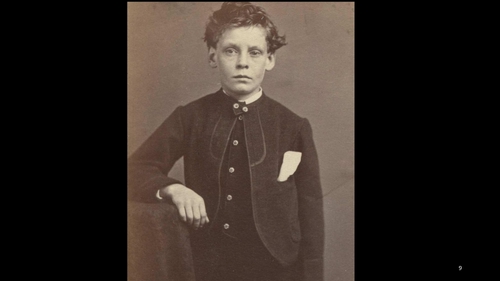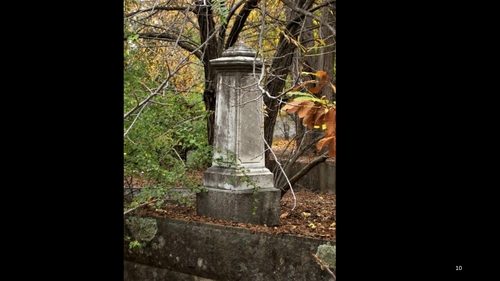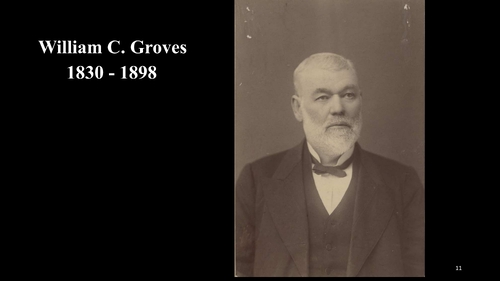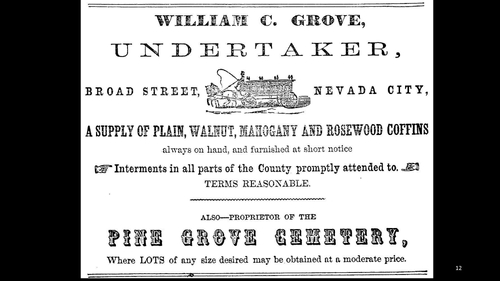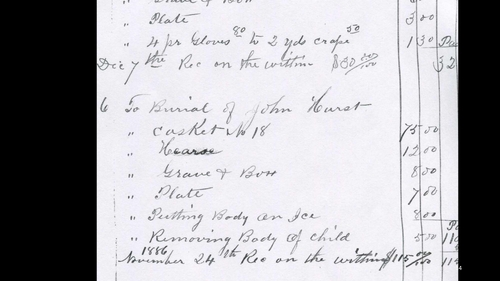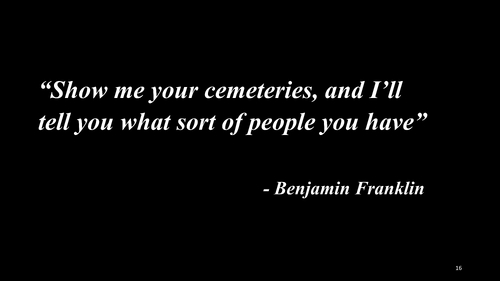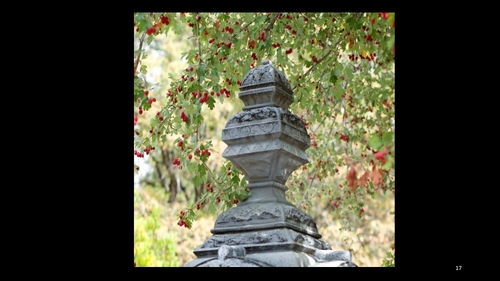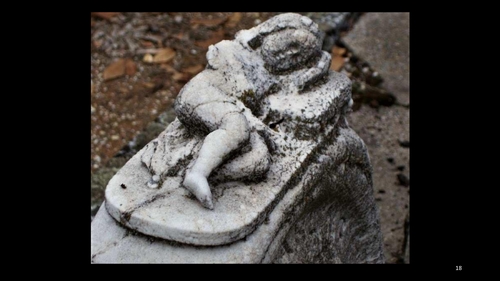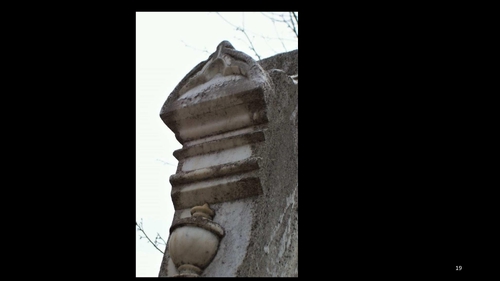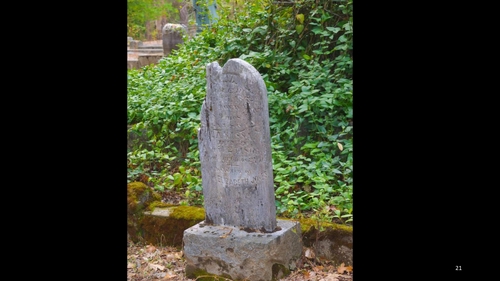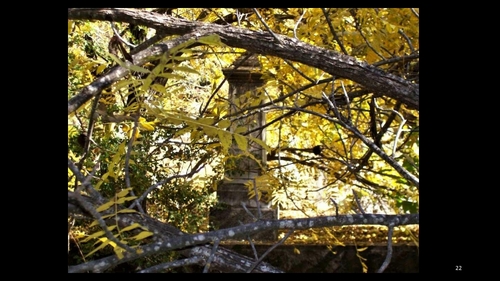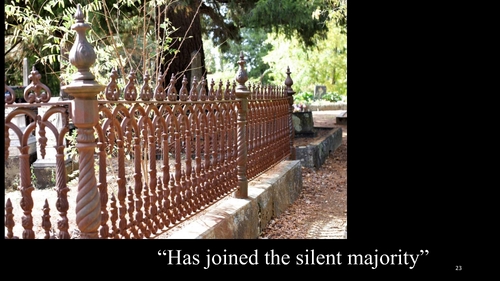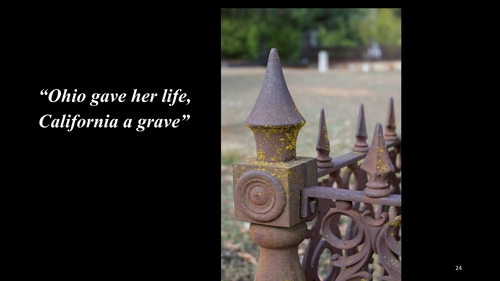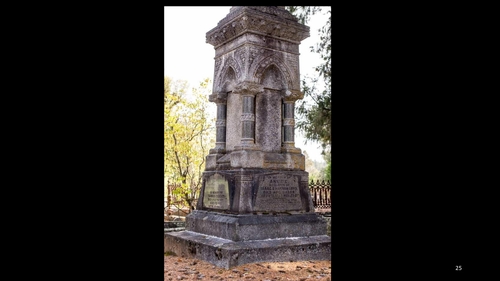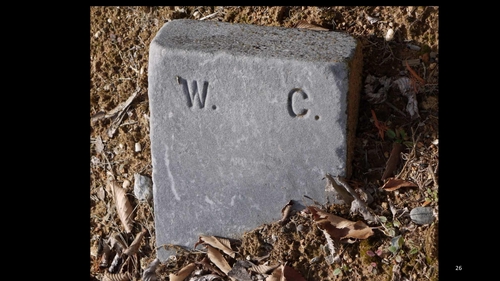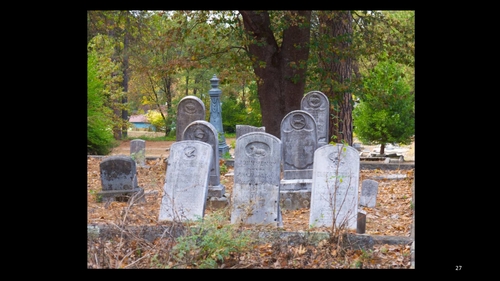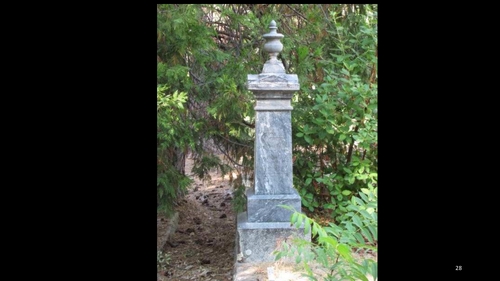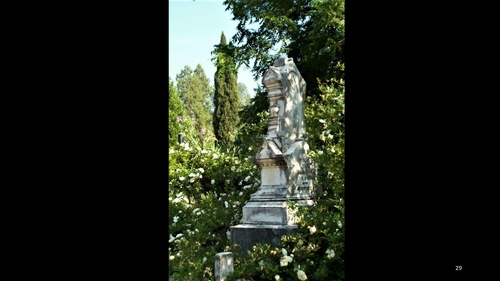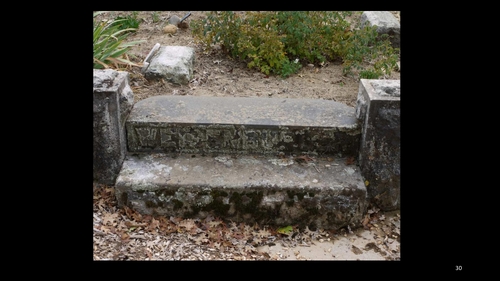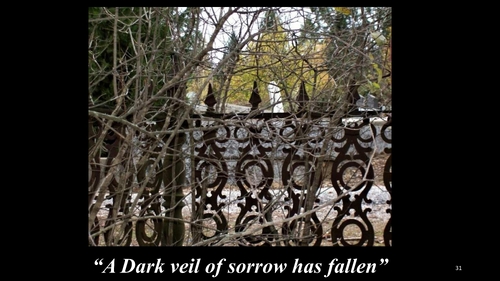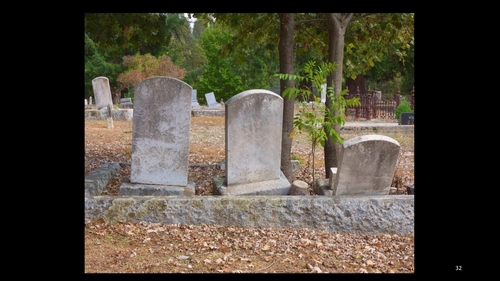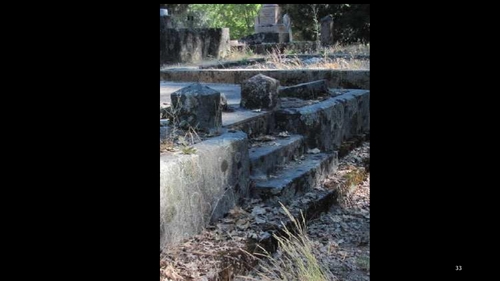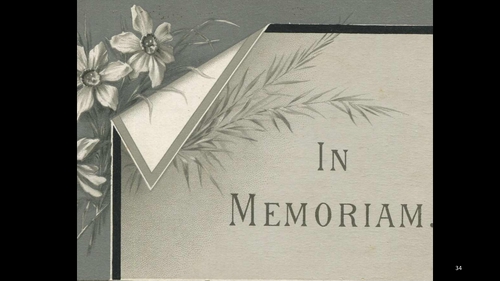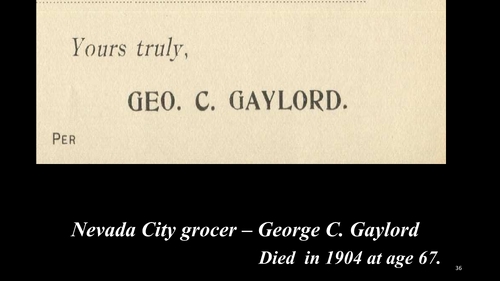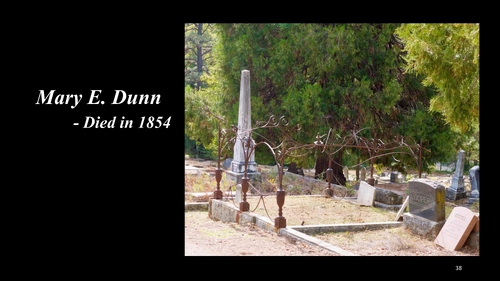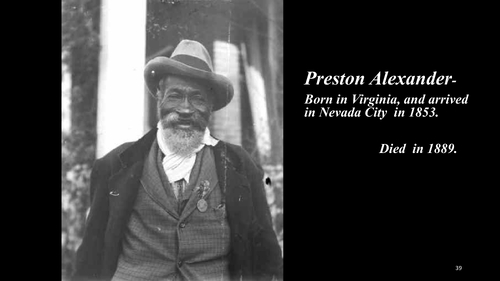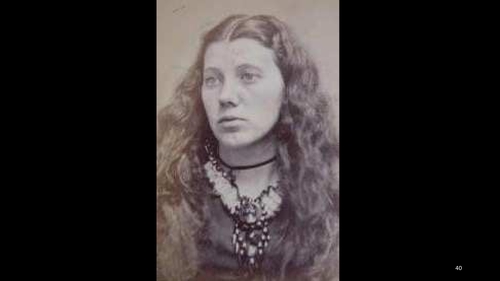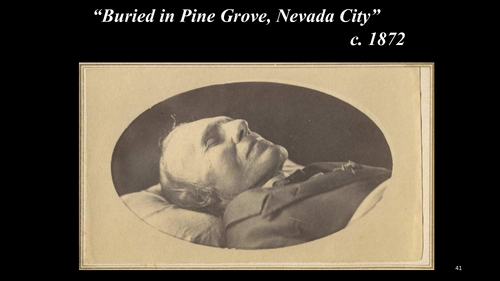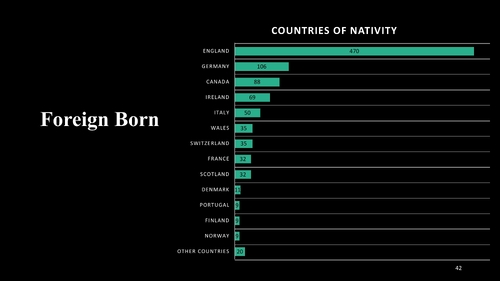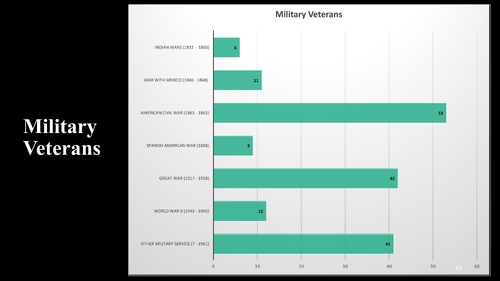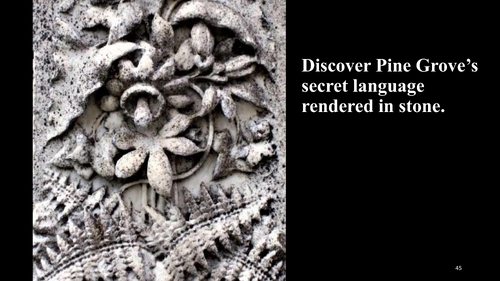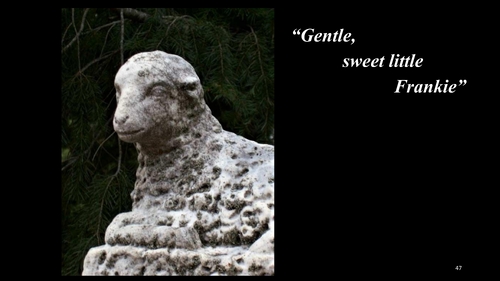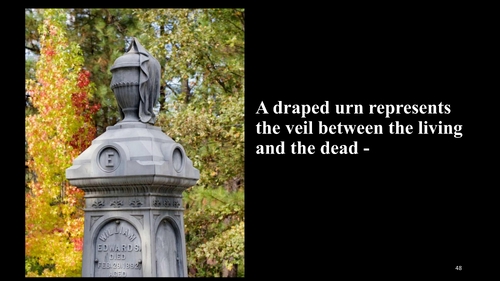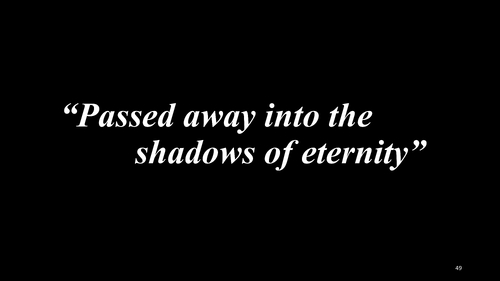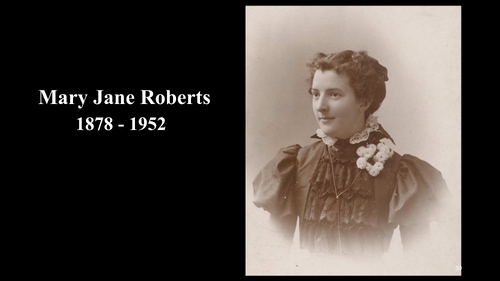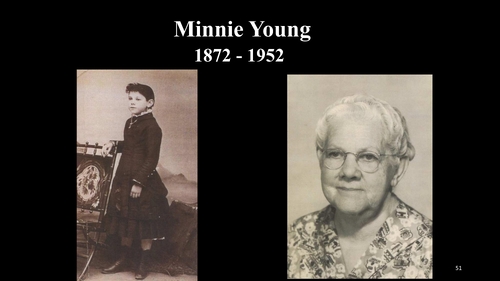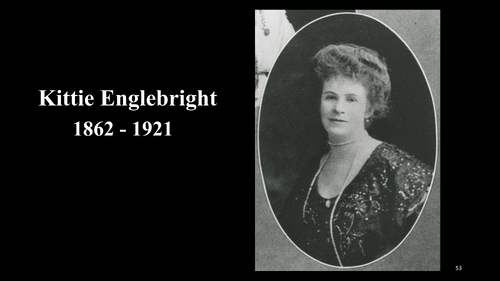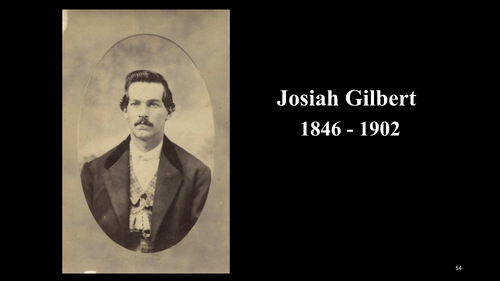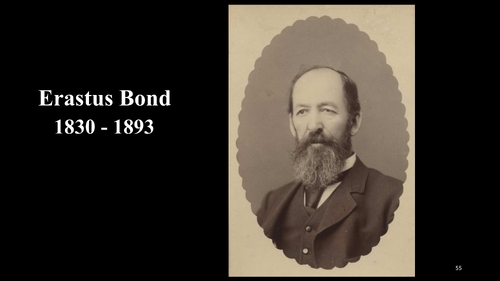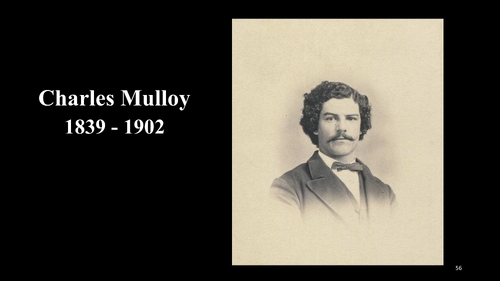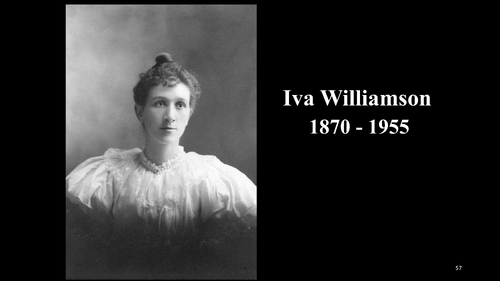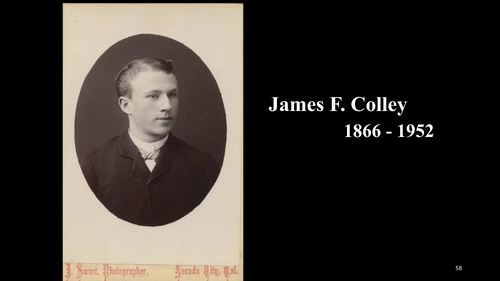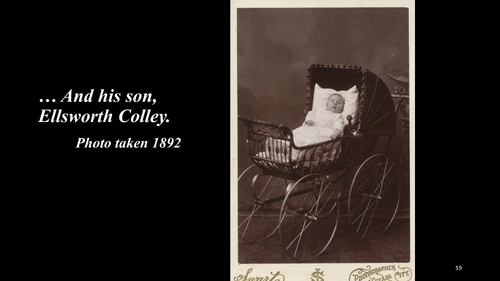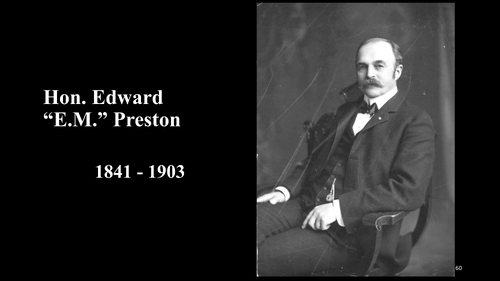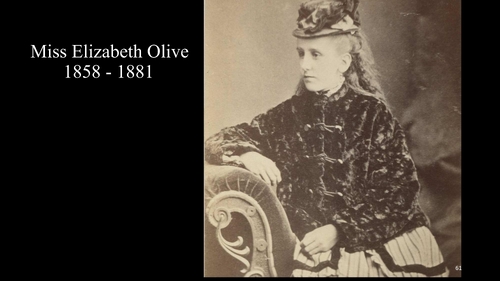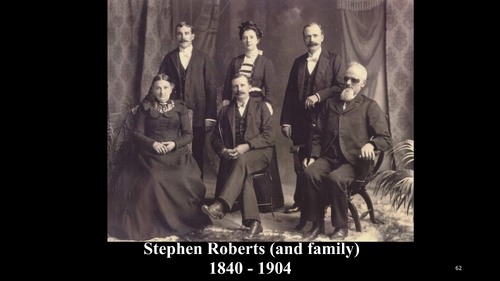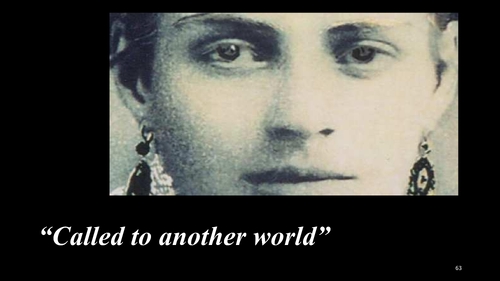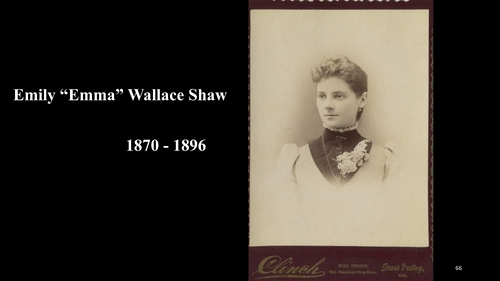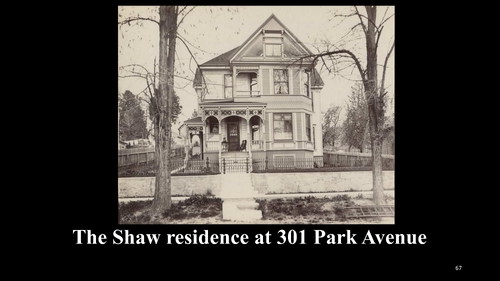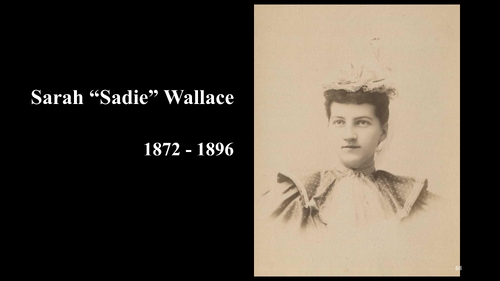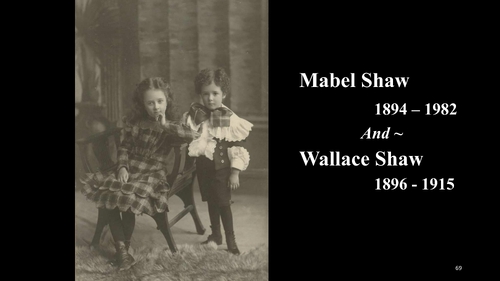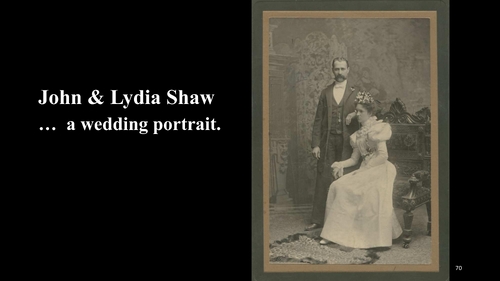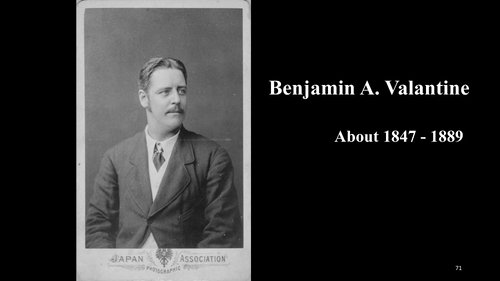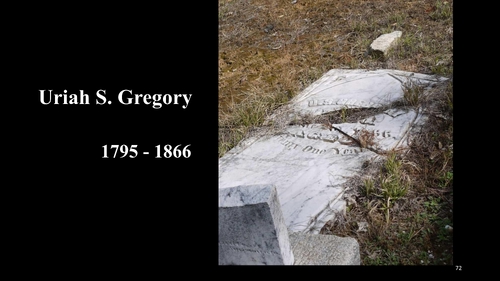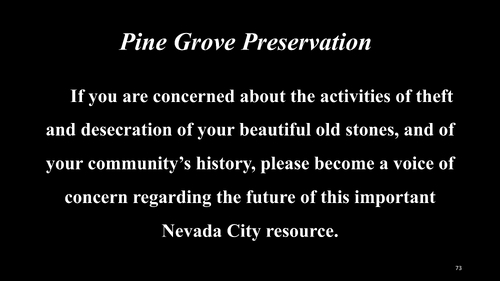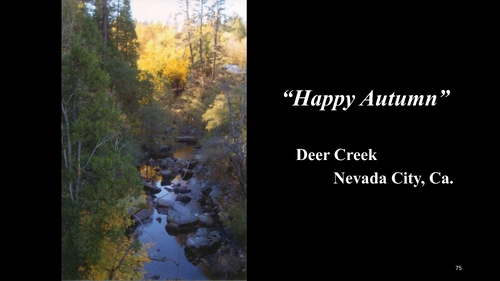Enter a name, company, place or keywords to search across this item. Then click "Search" (or hit Enter).
Collection: Videos > Speaker Nights
Video: 2023-09-21 - Nevada City's Historic Pine Grove Cemetery with Brian Suwada (58 minutes)
Their Spirits Took Flight is a fascinating look at the “residents” of Nevada City’s Pine Grove Cemetery. This beautiful book is produced in a beautiful hard-cover binding with high-quality paper and fascinating biographies and information. As you turn every page, you will get to know centuries’ worth of people whom might otherwise have been forgotten.
The book relates the history of Nevada City through the lives of some of the earliest pioneers. You’ll meet veterans of various wars, congressmen and other public officials, people who worked as domestics, miners, teamsters, and in the saw mills and local bordellos; all of whom left this Earth between 1854 – 1961. Their stories are here, featuring over 3,600 biographical sketches and more than 140 photographs and other images. The book includes a directory of pioneers and early citizens residing within, a cemetery map, and touches upon cemetery symbolism and death related customs of the late 19th and early 20th century.
Brian will introduce the audience to Pine Grove Cemetery, and some of the people interred there, whose lives parallel ours, yet we will never personally know. This talk will include slides of the cemetery and photos of a few of its permanent residents. The topic may not be suitable for everyone.
The book relates the history of Nevada City through the lives of some of the earliest pioneers. You’ll meet veterans of various wars, congressmen and other public officials, people who worked as domestics, miners, teamsters, and in the saw mills and local bordellos; all of whom left this Earth between 1854 – 1961. Their stories are here, featuring over 3,600 biographical sketches and more than 140 photographs and other images. The book includes a directory of pioneers and early citizens residing within, a cemetery map, and touches upon cemetery symbolism and death related customs of the late 19th and early 20th century.
Brian will introduce the audience to Pine Grove Cemetery, and some of the people interred there, whose lives parallel ours, yet we will never personally know. This talk will include slides of the cemetery and photos of a few of its permanent residents. The topic may not be suitable for everyone.
Author: Brian Suwada
Published: 2023-09-21
Original Held At:
Published: 2023-09-21
Original Held At:
Full Transcript of the Video:
Yeah. So. Okay, so I want to introduce tonight Brian Swata, say, for now. Swata? Yeah. Okay, that was close. Good. He's going to be talking about his book, "The Spirit Fook Flight in Nevada City's Historic Flying Grove Cemetery. " I met Brian for the first time yesterday. He's been a kind of a resident, I think, during his research at the Searles Library. But they were often, I never had a chance to cross paths with him. And I was surprised to learn that, I said, "Well, you aren't from Nevada County. " Our cue is presumably what he was. He said, "You had such a passion, but as I learned, you never lived here. " I didn't ever. So. Did all the research, kind of wrote the book remotely, more or less. But obviously, a lot of research is conducted here. So I'm excited to introduce Brian. I'm going to help with the audio visual, maybe tonight. There's a lot of slides to see. There's 75 of them. So we're going to zip through them. Hello. Hello. Okay, how's that? Okay. How do you turn this light on? Six-year-old. Oh, okay. I have that. Yeah. Let me get my speaking to you shakes out. There you go. All right. Usually, I would like to be sitting where you're all sitting, but tonight I'll pay my dues. And I wrote this book a couple, wrote this book a couple of years ago. Their spirits took flight. Nevada City's historic pine gate cemetery. And I thought that I would appear tonight to answer questions that people might have about the book. Thank you for the nice introduction, Daniel. And thank you for manning the slides for me. I'm honored to be invited here this evening. And without any other further to do, tonight we'll look at the history of your very historical town, Nevada City, from a different perspective, as we shine a little light on the souls who are buried in Pine Grove Cemetery. There will be talk of death. I hope you don't mind. Cemetery is the subject of cemeteries and the subject of death kind of go hand in hand often. So we'll look at through it and lighten up halfway through the presentation. It won't be gothic. It won't be dark, most of it. Before we get going, how many of you have been to Pine Grove Cemetery? So I have an idea. Okay, good. A lot of you have not been to Pine Grove Cemetery. So let's start with, what? Well, let's, I'll tell you how to get there. Starting in downtown Nevada City, let's say Broad Street by the National Hotel, go up Boulder Street and Boulder Street jogs a little bit to the right. That's Red Dog Road. And if you look up to the right side of the road, you'll see a vast cemetery laying out before you and that is Pine Grove. Can you do a slide, please? Maybe do one more slide. Okay. All the photos in this presentation are of deceased Nevada City residents. The poetic Victorian and Edwardian quotes were taken from 19th century and early 20th century Nevada City newspaper obituaries. There's a lot to talk about with Pine Grove tonight and we have a lot of slides to get through so I'd ask that questions. Wait until the end of the presentation, please. I told you about the book. I will have a few copies available afterwards. It'll be $35, no tax, and the total amount will be donated to the Searles Library. I hope tonight inspires you to do your own explorations of the cemetery and the people there. Slide, please. And there is the cemetery way over there which is about eight and a half acres from the original 10 acres. I do not know what happened to the one and a half acres but okay next slide. And the next slide. Okay here we go. I believe that time does not heal all wounds. Grief takes a lifetime to process. It weighs heavy on your heart and heavy on your soul. Slide. When you enter Pine Grove Cemetery you're entering Nevada City's wild and wonderful past. You are following in the footsteps of miners, politicians, madams, ministers, and musicians, all converging on the city from destinations around the world. Their lives show just how difficult and how demanding life in 19th century Nevada City could be but also how rewarding and exciting as well. In Pine Grove Cemetery we are not only standing among the dead, we are standing in the history of this town. Considering how difficult pioneer life was I was surprised at the number of people who lived into their late 80s and 90s. I was struck by how many people died after having an appendectomy, that's after having their appendix removed. Was it an exploded appendix? Was it enough surgical practices? Or maybe it was sterile lack of sterilization. Slide. Pine Grove Cemetery, lonely place of sorrow where tall cedars have seen many tears shed over the years is now a place of community resource and reflection. When I am in Pine Grove I feel connected. I feel a connectivity, there we go. I feel a connectivity with those who were here first where many of you live every day yet will never meet. Next. Tremaine Roberts, Charanat Bennett, Chapman, Engelbright, Janassi, Hosking, Williams, Holbrook. These are a few of the names you will see when you go to Pine Grove Cemetery. Next. Nevada County Poet Laureate Kirsten Casey whom I had the pleasure of doing a brief presentation with at the cemetery last fall has written lovingly about Pine Grove Cemetery and the stones that remain. She says and I quote, "I think the stones mattered most to those left behind, the living. They wanted their loved ones to always be remembered so they immortalized them with stone. Something tangible, something permanent that promised to remain. When everyone who knew you is gone who do these stones matter to? Historians? Archaeologists? A curious visitor? And what is our responsibility as a visitor to the cemetery? Next. Okay. In September of 1860, W. C. Groves, gold seeker, cabinet maker, undertaker, fledgling undertaker I should say, purchased 10 acres of land from Joseph B. Yates along Red Dog Road for the purpose of establishing a cemetery. He laid out the cemetery in two streets, blocks, and plots, and he named the cemetery for his wife Mary Ann Groves. Next. He opened up his cemetery necropolis for business in February of 1861, though people had been buried in the location where Pine Grove is since 1854 and probably before that as well. Groves himself had been working as an undertaker since 1859. Slide. Groves sold portions of the cemetery to various fraternal groups, night's epitheists, godfellows, etc. Each group is responsible for maintaining an individual fraternal cemeteries under the umbrella of the whole cemetery, which is known as Pine Grove, so you could say that Pine Grove is a collection of cemeteries. Groves applied his cabinetry making skills to the construction of coffins. He kept ledgers detailing the costs surrounding each individual buried not only in Pine Grove but in other cemeteries nearby. Slide. Details included horse-drawn herbs, black-colored fridge, ribbon, fringe, coffin, handles for the coffin, grave digger to open the grave, pallbearers gloves, engraved coffin plate with the person's name on it, ice for keeping the bodies fresh, especially in the summer, ice was sourced from Lake Tahoe and Alpine lakes and surrounded with straw and brought to Nevada City and stored in subterranean areas to last, not melt. In the wintertime when snow lay upon the ground, the minister, the corps, the family members, the mourners, the pallbearers, all were sledded into Pine Grove Cemetery by horse. Slide. William Grove's three handwritten ledgers are one of the many treasures you can find at the Searles Historical Library. You never know what interesting things or interesting people you'll find at the Searles. Looking at the ledgers we see that he didn't list the name for some people. Some people were called the Jew, the Portuguese, see the bottom is his burial of a Portuguese child. And there's a lot of Chinaman's people with a last name Chinaman, not, that is not a last name. As the years progressed, WC's penmanship improved and people actually had to name all people of first and last name. Slide. As I show you a few photos of the cemetery taken recently, I'll tell you about a few people buried in the cemetery. Next. Nevada City had a few uncertified physicians and dentists for sure, but Dr. Mary Elizabeth Little was not one of them. Dr. Little graduated from the medical department of Ann Arbor, Michigan and became a registered physician in 1885. She ran a successful practice in Nevada City for many years. The majority of her patients were women and I can't help but think in how relieved the women were that she chose Nevada City to live. Next. Jenny Kissel, Nevada City's pride, mother of 20 children and none of them were twins or triplets. Noted as the largest family in California, they were highlighted guests at the 1929 State Fair in Sacramento. The residents of Nevada City would pool their money together to help this family out. Next. Aviation pioneer and inventor Lyman Gilmore, he claimed he was the first to fly. Unfortunately, the hangers which housed his early model planes were lost in a fire in 1935. All his records and proofs of aviation went up in smoke. Next. James Collins, or I should probably say Brigadier General James Collins to you and I. Slaughter of the Sock and Fox, the Potawatomi, and the Kickapoos, he commanded a regiment in the Black Hawk War of 1832. He was appointed a Colonel in the Mexican War and was commissioned a Brigadier General of the California State Militia by Governor Leeland Stanford. He was a 49er having come to Nevada County in 1849. Next. Benjamin Hooker Johnson, an escaped slave, spent 55 years of his life in Nevada County. Next. Frau Franziska Ziegler, her bloody body was discovered in a woodshed behind the National Hotel with cuts and wounds all over her head and a clothesline tied around her neck. Was it murder or was it suicide? The jury could not decide. Next. Frank Holbrook was one of the last surviving stagecoach drivers. He traveled between Nevada City and Downeyville for 40 years. Every evening he would brush his horse's coats until they were nice and glossy. Next. Helen Bates arrived in Nevada City in 1852 with Oxen. She buried four husbands and then decided she had enough. Next. Usually you think about the men working their wives to death. Well, she worked her husbands to death. Okay. James Teal, his grandfather was a member of a donor party. He told of how he had left the party in order to bring back relief. He found help from New Helvetia and on returning to the starving party, they stopped at a spot above present day Nevada City. They built a little structure to stash food for the return trip. They named the water source there Deer Creek. When they came back, they found animals had ransacked their cachet and Steel's grandfather had to roast parts of his boots to sustain his companions. Next. Henry Damon. He sold snakes in Chinatown and he died from a rattlesnake bite. Next. Thomas Savory Ford was the son of the daughter of the English Earl of Bresingham. In 1861, Thomas, his mother and three others rode horseback from the East Coast to California. Thomas has the dubious title of being the first person killed in an auto wreck in Nevada City. That would be 1910. Next. Mary Ann Place. She was the lighthouse keeper at Point Benita on the Marin Headlands and it's notable that she made the same salary as a man-made at that time. She welcomed gold seekers laden with people into the Golden Gate. She attended the first inaugural ball in California and spoke at an annual pioneer reception even though she was over the age of 90. Next. Nellie Bond. She brought the first piano to Downeyville. Birdside Bullard. Birdside was known as Poseidor a vinegar man. He balanced jugs on his head while he skated. He operated a roller skating rink and on his wedding day inside in Nevada City, people should skate for free. Next. Douglas McLaren. Millman at the Erie Mine. He was found dead in an ore cart. He was sitting upright on a chunk of quartz holding a lighted candle. How would you like to find him? Next. Lou Engen, also known as Big Lou, was a highly respected school teacher having graduated with honors from San Jose Normal School, now known as San Jose State University. She enjoyed the flirtations of other men and divorced her husband in Sacramento. She then headed for Nevada County and was not in Nevada City for very long before reaching the bottom of immoralities to Bauch and Slide. She discovered her true calling as a madam and she ran the most flagrant and notorious house of prostitution in all of the foothills. A very fiddly woman. Next. Billy. Billy was the town dog who belonged to Saloon Keeper, Hermocnes Pecherdi. That's right, I'll say it again. Hermocnes Pecherdi. Billy starred in a theatrical production of Uncle Tom's Cabin playing the part of a bloodhound. Everybody knew Billy and he was much left by the town. He was given his own grave and his own headstone in Pine Grove Cemetery next to his master. Next. Hermocnes Pecherdi. Hermocnes gave out 150 free turkeys from his Saloon every Thanksgiving. Both Billy's and Hermocnes headstones have been removed and stolen. They were in an area that I called Baby Land in area J of the cemetery on a cemetery map. When I first started doing a field study of the cemetery in 2007, there were more headstones and there was even a large rose quartz, what I want to say, pillar, head marker that was partially dug and then came up again and it was gone. And I remember I should have taken a picture of those two headstones of the Saloon Keeper and his dog because they're gone. And I called the area Baby Land because there were little markers and rattles and plastic flowers and little metal temporary signs scattered throughout for babies and someone removed all of it. It's all gone. It's just flat. Okay. Slide please. In reflecting on the spirits took flight, lists start to form in my mind like who was murdered, who committed suicide, how many French people immigrated to Nevada City, how many people were killed in the Spanish flu epidemic, etc, etc. Here's a few interesting facts. Next please. The Spanish flu pandemic of 1918 through 1919 killed at least 18 people who are buried in my pine grove. Here's a picture of my great great aunt. She died from the Spanish flu and she contracted it at her home in Berkeley. There's a lot of people who were from Nevada City, they went other places to live and when they died they were brought back here to be buried. Next. At least one dog and one cat are buried in pine grove cemetery. A much loved tomcat named Billy greeted shoppers at Nevada City Grocer George C. Gaylord's store. I know his cat was named Billy, the town dog was named Billy. I don't know. I guess it was a popular name. But what I wonder about is how many pets were actually buried in Pine Grove. Next. By the year 1897 people that had a telephone were able to reach the undertaker by dialing 283 or asking the operator to be connected. Next. The oldest documented burial is Mary Dunn who died in 1854 at age 15, six weeks after she arrived in Nevada City from the state of New York. And there is the Dunn's plot with a wrought iron metal sculpture. It looks like people have been hanging from it and bending it. That would be an interesting family for someone to research. Okay, next. I was able to confirm at least 11 people buried in Pine Grove Cemetery who are of African American descent. And of course, I'm sure there are likely more. A shout out to Linda Jack who is doing wonderful work with her involvement in publicly honoring some of these early families and individuals. Next. This is a Nevada City one that I found. I found pictures of Nevada City people all over at ephemera shows which are antique paper shows. At an estate sale I found a number of them in Arizona at an antique store. There was a family's photograph. Some of them are my family's, different places. Family's, it says Nevada City, California on the back and that's it. But she looks like she could be mourning and that looks like to me a vulcanite mourning necklace she's wearing. But I can't be sure. Anyways, murders and questionable deaths. There were only 34 of them and all those years 34 questionable deaths are deaths that are suspected as murders that remain unsolved. Remember there was no DNA testing, no surveillance cameras. Forensics was rudimentary at best. It wasn't until 1911 that the courts allowed fingerprinting as evidence in the United States. It seems like it was easy to get away with murder back then. Thanks. Okay here's another fella I found. Yeah he's a dead fella. It's a corpse and on the back it's buried in Pine Grove, Nevada City. And I judged that it was 1872 by his lapels and by the horizontal oval and the picture was popular in the 1870s and it was a cart to these eight small photographs. Anyhow I thought that's appropriate for the next leg. So how did they die, the people in Pine Grove, how did they die? Well are you ready? Okay well let's play sort of a game sort of. I'm going to list all the manners of death and you count all of them and you can keep it to yourself and at the end of the evening I'll reveal the answer and if you are correct you may get a prize. If there's too many to get out of there we'll have enough prizes. Okay hold on. I'm going to need some water for this. Let's go. Heart attack. Heart attack, auto accident, childbirth, minor's consumption, drowning, cancer, gunshot, stabbing, cyanide poisoning, pneumonia, mystery illness, family feud, tuberculosis, leukemia, falling into a hot water kiln, blown up by dynamite, found dead beside the road, floating down Deer Creek, stroke, slipping and falling, killed in military action. Accidental shooting, falling from a cliff, hit by an automobile, house fire, gored and trampled by a cow crushed by logs eating poisonous mushrooms, hunting accident, falling off a ladder, falling down the flat of stairs, forest fire, wind over a waterfall, surgical complications, cave in, killed in a train wreck, rattlesnake bite, mind blasts, struck by a child riding on a sled, cholera, falling down a mine shaft, tiptheria, scarlet fever, crushed under a horse, meningitis, killed by bandits, chronic alcoholism, straightening poisoning, run over by a train, sled walked out a second story window, struck by a runway or a cart, choked on a coffee bean, electrocution, beaten to death in a fight, jumped from the Pine Street bridge, typhoid fever, hanging, influenza, overdose of morphine, seizure disorder, impaling, jealous levers, carbolic acid, pinned under a tree, mountain fever, fell while working on a bridge, blood poisoning, throat slashed by a razor blade, dress caught on fire while cooking, mineral solidified lungs from working in the mines, whooping cough, runaway bugging, lead poisoning from years of working as a newspaper printer. Over study for college exams, minor scandal holders spike into the eye, boulder landing on the head, pleurisy, shock from seeing a boy kicked in the head by a horse, hepatic colic, drowned in a barrel of water, eaten by pigs, suspicious circumstances, froze to death, mangled in mining machinery, oil of cedar, grief over the loss of a child or a spouse, dropsy, playing with guns, gas explosion, head over the head with a bottle, eating deviled ham with toenailies. That's it. I hope none of these things happen to any of you. Next. Okay, foreign born. Out of the 3,697 people documented as being buried between 1854 and 1961, 993 were foreign born. And as you can see, a large number of them came from the British Isles. A whopping 470 came from England, and those 212 came from Cornwall. There's a fella I know who lives in Pending, Cornwall, and he told me that after thinking about it, he thinks of Nevada City and Grass Valley as being St. Justin, Pending in the mountains. I said, "Why?" He said, "Because so many people from Pending and St. Justin moved to Nevada County. " And as you can see, a few people came from other countries. I lumped a bunch together down there, 20 of them, and out of those 20, one person came from China. His name was Hong Li Aajak, and he wanted a western-style funeral, so he got one. Next. Military veterans. Well, it looks like the American Civil War won the prize with 53 veterans. And it is important to know that they're not all Union soldiers. There's a number of Confederate soldiers, too. I bet that comes as a surprise to people. Six Indian war veterans. Four of them fought the Paiute in 1860 at Pyramid Lake. Next. Victims of murder. I didn't really know what to say here, so I listed them chronologically. 1866. And it looks like the last one was 1946, so I documented people through 1961, so it looks like for a number of years there were no murders here. Or at least people that were buried in Pine Grove. They could be in St. Canis or other cemeteries. Next. Cemetery symbolism. Pine Grove Cemetery is rich in symbolism. Beyond the name and date of birth and the date of death, there's a lot more that can be learned about a person by looking at the funerary emblems carved in the stone. It's kind of a hieroglyphic cemetery language, if you may. Here are a couple of examples. Next, please. The lamb. The lamb of God. Lambs represented innocence and purity, and they're usually put on the graves of infants and children. Next. Next. And urn represented death and mourning. If it was veiled, the veil represented, what did I say, a veil between the living and the dead. Next. Okay, now let's have a closer look at some of the people that are buried in Pine Grove. Stay with me. There's not that much more to go, but some interesting things. Okay, next, please. Okay, this is another great, great aunt of mine. That's why I know some personal information here. Mary Jane Roberts lived in a house on Sacramento Street that she kept dark with thick velvet curtains. As you look down her dark hallway, and this is according to my mother, there was a kitchen that was kept lit, and it was a happy place to be where a canary always happily sang. She lamented that in her youth she was forced to play the Oregon F funerals. She was slipped into her very first course set at age 12. Next. Many young, young many, and old many. Many claimed, many claimed, hello, okay. Many claimed that throughout her life that she was kidnapped as a baby. Actually, her mother died when she was four years old, and a nice young English couple named the Delbridges adopted her. She owned a dairy on Park Avenue in what is now part of Pioneer Park. Nevada City made several attempts to buy her land from her and her husband. After her husband died, Nevada City took her land through eminent domain. Next. Again, young and old. He looks pretty much the same throughout his life, doesn't he? William Fellows Englebright was an executive committee member of the California State Minors Association. He was elected as a United States congressman in 1906 and reelected in 1911, and his wife, next. Kitty Englebright, born in Virginia City, wife of U. S. congressman William F. Englebright, and mother of U. S. congressman Honorable Harry Lane Englebright. Think of Englebright Dam. Kitty was a Washington, D. C. socialite and a good friend of Mrs. Theodore Teddy Roosevelt. She served on the woman's board of the Panama Pacific International Exposition in San Francisco. Next. Josiah Gilbert, nationally acclaimed mining expert. His advice was often sought after. He kind of resembles my cousin Bruce who's here. Okay, next. Arastus Bond, a member of the first legislature of the state of Nevada, elected county assessor in 1886. Due to his extensive prospecting expeditions, Arastus was responsible, and with his wife she went with him, responsible for helping to open up many Sierra mining regions. Excuse me. Next. Charles Malloy, successful Nevada City businessman and community leader, built a house in 1880 at the where East and West Broad Street meet. It came as a shock to the citizens of Nevada City when they heard that Charles was found dead at home hanging from a rope. Next. Aiva Williamson, appointed Nevada City librarian, a position she held for 28 years. Next. James Collie, former postmaster, he owned Collie's Candy and Confectionary on Broad Street near the National Hotel. His home is now known as the Deer Creek Inn, or what as I drove by and I didn't see a sign out there, but it's the where your car lot is by the creek and you go up Nevada Street, it's the first Victorian on the right, that was his home. Next. And his son Ellsworth. So now you know that people did push a pram around the city of Nevada City here. Next. Honorable Edward Myers Am Preston, elected state senator in 1888. Myers authored a bill which created his school for bad boys, also known as the Preston School of Industry in Ione, California, which is located near Fremont. Perhaps you've heard of the buildings named Preston Castle. Myers was rather grand. In 1895 he was elected the grand master of the Grand Lodge of Masons for the Grand State of California. Next. Miss Elizabeth Olive, she was born in Lancashire, England. That's a sweet picture. Next. Stephen Roberts, born on Queen Street, Bizorrent St. Just Cornwall. Stephen went to California and worked at Minding for five years before deciding that Nevada City would be the place where he wanted to raise his family. His wife had died so he went back to Cornwall to pick up his two boys, John and James. As he stepped off the gangplank in Hale, Cornwall, Elizabeth, Eliza, sorry, Eliza Martin, saw him and said to her girlfriends, "I'm going to marry that man. " And she did. So Stephen took his new wife and sons with him to California, sailed around the Horn, and ended up in Nevada City. His mining days ended after he was blinded in a mine blast at the gold tunnel mine on Lost Hill, and then purchased a building on Broad Street and opened a variety store next to utopian gold on the corner of Broad and South Pine. Next. And his first wife, Mary, that's my great-great-grandmother. She's the one who died. She did not make it to California, but since I'm doing this presentation, I thought I'd add her. Okay, next. Okay, Dr. Nellie Chapman. Nellie became the 14-year-old bride of 34-year-old dentist Dr. Alan Chapman. They were married in a double wedding at the Williams' home, known as the Red Castle on top of Prospect Hill. Nellie learned her dental skills from her husband. In 1879, she received her dental license and is recognized as the first female dentist in all of the American West. Next. Okay, Dr. John F Shaw. John practiced dentistry for 40 years, but he never went to dental school. He married Emma Wallace. Next. Oh, and by the way, can you go back one for a second? I think this is the first documented photo of someone working from their home office. His office was in his home. Okay, have fun. Next. Okay, Emily Emma Wallace Shaw. This is John Shaw's first wife. Emma passed away in the homie belt for her at 301 Park Avenue. Next. And there's the home. Maybe some of you have noticed it on your way to the park. Next. Sadie Wallace, Sarah Sadie Wallace, Emma Wallace Shaw's sister. She was a self-employed dressmaker and she died four months after her sister died. Next. Mabel Shaw and Wallace Shaw, John and Emma Shaw's children. Wallace died a very young woman attending dental school and Mabel lived a long life. She worked as a nurse and later married. Next. This is a picture, wedding picture of John Shaw and his second wife, Lydia Shaw. She was a wheeler from the Wheeler family in Grass Valley. Next. Benjamin Valentine. Benjamin left England to marry his Nevada city first cousin, Elizabeth A. Valentine. They were married in Kobe, Japan in 1878. Benjamin managed two large import businesses, one in Japan and one in Shanghai. Next. Uriah S. Gregory. Uriah Gregory arrived in Nevada County from Kentucky with five slaves. In 1866 he served as the county jailer in Virginia City. Two inmates hit him over the head and threw him in the jail cell and he died later from his injuries. As you can see from so many of these broken and desecrated monuments that the state of High Grove Cemetery is rapidly deteriorating. Next. Let you read that. In closing I would like to suggest that the community begin to think about conservation and perhaps even restoration of the cemetery, pioneer cemetery as well. Next. Perhaps these thoughts can begin the discussion. The first one is, was I took it from the Santa Rosa Rural Cemetery, Santa Rosa, California. It worked for them. It could work here if there's enough interest. And the second idea, the amnesty program I thought of cities like Oakland have had amnesty for guns and that type of thing. I thought why not amnesty for headstones? There's a number of them that have been stolen. Billy and Hermoides Pecerides headstones were stolen. This happens in his cemeteries all over. Here's a problem in Virginia City as well. There's a gentleman I ran into and he said that he went to a cocktail party some years ago in Marin and there was a coffee table and it was a tombstone and something with a glass over the top and it said something died NEV Comic Cal. So was it from pioneer cemetery or was it from Pine Grove? I don't know. But there are people that go in or out looting and I don't know what could be done about it. It happens everywhere. Thank you for your time and attention. This evening I look forward to answering your questions now and perhaps meeting some of you over refreshments. So yes. I noticed in this area a lot of family plots and individual grades are covered with concrete and that's not so true in other areas. You know what that is? I can only speak for my she's a cousin but she's so much older she's more like a great aunt my cousin Esther what she did with the family plots in Pine Grove she hadn't cemented over because she said that it was a long time ago but she said that people could bury people on top of you once you're forgotten about so she hadn't cemented over. That's my answer. Okay anyone else? Yes. I don't know. I've thought about that myself and I wasn't even sure about the cemetery being named after his wife but that's what I had read in a source so I don't know why the last got locked off work. Ask the Searle Library? Yes, yes. Ask at the Searle's library. They have all the answers. That's a cop out for me. Sorry. Yes. Well aren't the Searles buried in microbe? Yes they are there also. I didn't mention them because I wanted to highlight some people that you probably haven't heard of because a lot of the same families get the attention which deserved deservedly so but I just wanted to highlight some other people that might not be very interested to poke around there some more. Yes. Yes. In a share of a lot of the cemeteries as well, I've only lived here 40 years, but going up to the Pine Grove Cemetery and then going on up from Broad Street to the St. Canvas Cemetery that's beside that, the Sergeant is very, but distressing is how many slarish truths were taken out. Oh. And I thought who's making the money pulling out the beautiful trees? And I was told that one tree was taken out only because it was only water so I'm calling it. But many trees I called out and each of those and I really didn't get an answer. Well I don't know. I don't live here. I can tell you that the cemetery, Nevada County Cemetery District is in charge of all of the roads throughout the cemetery, all the cemeteries in Nevada County and but not the burial grounds part. I had an, I did originally include an original map of the cemetery that was provided by the cemetery district. It said Merchie Road instead of Red Dog Road. Do people still call it Merchie? They do still know. Well that and there's areas defined by trees and I thought trees get chopped down. They don't last forever so I thought I wouldn't include it because it's, there's a map in the book here that's based off of that, but as far as I don't know why they cut the trees down and probably a neighbor complained about the tree and it's expensive to cut trees down though. So yes. From start to finish when you started your research, how long did it take? Thirteen years. But, but I have to tell you it's like, like one year I had no interest at all. Why do I care about these people and all this stuff in this other city and I lived in Santa Rosa, California so it made doing research very hard. I came up here and did field studies. I contacted Hooper and Weaver Marchuary. They didn't have any plots. There were some plots listed. The masons told me that they had something for just the Masonic Cemetery but not the rest of the cemetery and so I walked through that came up here and I have a lot of coffee and I just pop in and say hi to Pat and then she got to deal with all my energy and everything. Left the Beatles with the dog sitter, cost money and all, come up here and drive three hours and then walk around in the heat and then go back three hours. So I did all that for a while and then I put out flyers in different places and I interviewed some people in retirement communities. I should have started this years before and asked if they had great collections of people who were buried in Pine Grove before 1961. So and I didn't know what I was doing. I just started looking around the cemetery at headstones and writing everything down at first and so it was a growing process but what took most of the time, like 80% of the time, was going to the state library, driving to Sacramento to look through microfilm and then I started having it sent to me so they'd send a reel at a time and that's all that they were allowed to send to Santa Rosa Public Library where I worked as a librarian. So my lunch hours they'd go out there and look on the microfilm and look for people who were buried in Pine Grove. So that's why it took a long time getting the resources. Yes. I made it wonderful that you have a library background but how did you document it? How did you file your business? This information, how did you. . . Well, I. . . Oh my gosh. Well, my closet was full with stacks of papers, stacks and when I moved to Rancho Mirage I threw 95% of it away. I thought I'm not taking all these dead people with me. Get rid of it. Recycle it. But everything like the interviews of people I kept, everything that I found in microfilm I copied to look at later, to disseminate later. I just, you know, it's so easy to go down the rabbit hole and find a lot of interesting articles. I saved some things about, like there's documented slave sale at Bidwell Park Bar in 1850 something and just a lot of really interesting local stuff. I've saved a number of articles about horses, local Nevada City horse stories, but it just, it was really a lot of work to talk. So I saved all of that and then put it together what I thought was interesting in this book. Yes. What is the earliest kind of map or layout that you found primarily or were there in the early. . . The earliest I could get was the same map that came from the cemetery district and it came from, the same map came from the odd fellows, they contacted the odd fellows and they were happy to share a map, but it was the same map. It's, let me show you a picture of it. Doo doo doo. One more page. It's small, but maybe that's too small to look at, but this was from the, this is the oldest map I get and I doctored it up. So if you buy the book, you get the map. Yes, and if you buy the book, the money is 100% goes to the Searle's library, nothing to me, so this would be a good time. So I have a question for you. Yes. I noticed that you, there was no mention of criminals, murders, prostitutes being buried in the cemetery. Oh, they're in there. I mean, I had 3,967 people and I just picked a handful of people. Wow. So it was really hard. I mentioned Big Lou the Madam. There's another Madam, there are two Madams, several prostitutes. Murdered. A couple of women, a couple of women who I suspect is being prostitutes just because their families didn't want them and they had multiple names, but, um, murderers? No, there were definitely murderers. I ran across a number of those articles and some went to San Quentin and I did not find any murders. Did I? No, I don't think I had any murders, but I, there are plenty of, yes. Yes. Was the grave segregated by ethnicity? No, it wasn't segregated by ethnicity. There were a number of African Americans, one person, lady from Chile, another woman from Mexico. Catholics were buried in the cemetery too, not just across the street at St. Canis. The one Chinese person who wanted a western style funeral, as I mentioned, and I imagine that that meant, I hate to say it, but the Chinese at one time were considered heathen because they weren't Christian and they went to their Chinese cemetery, which you probably know about. But this one fella, he was a janitor and he was well liked by children because they liked to give him candy and they followed him around and he was a mining camp cook and he got his western style, um, funeral. And so, no, they weren't segregated, yes. With all of your knowledge, I'm not aware if there's a Native American secretary as such. By the way, there's a Native American Indian scout buried there and he scouted for, I forget, the commander against the Sioux Indians at one time and he's buried out there, but a Native American cemetery. I think that there is one here. I think the locals here probably know about that. I know there is one, but I don't know where it is. Okay, there's the answer. I just can see there's also two Jewish cemeteries in the United States and the West Side of the right. And the Jewish people, from what I, I read an article in the 18th, the late, the last burial of a Jew in the Jewish cemetery was in 1893 or 1894. From what I understand, a lot of them, the families moved to San Francisco. Yes. Is there anything going on to try and preserve these cemeteries locally? There's nothing going on? Nothing, and that's who I just touched on. There's nothing that I know of. Has anyone heard anything? The masons kind of clean up their area. They keep their area pretty clean and they've really worked on the oddfellow's area. And other areas look like they haven't been touched and there's more tombstones turned into rubble. I was there yesterday looking around a little bit and doesn't look like, I hear the boy scouts going maybe once a year and clean up some. But really, I think at this place, my personal opinion, and I know it's a pipe dream, is to close the cemetery at night. And because there's all kinds of people that hang out there. I mean, it's a great place to walk a dog. I saw some kids playing with their parents. I played hide and seek as a kid there when I was little with my mom, but now I'm too old. It's too close to my reality to be doing that. And jogging one time and then one time there were two men. I saw them on two occasions and they came up to me. They had a camper and they wanted to know what I was doing here because they were the king of this place. And I thought, I said, well, I'm doing some work for Pat Chesnett with a historical library. So they figured there would be someone that knew about me poking around the cemetery. Any more questions? One more question. One more. Are you going to give the prize for who counted? Oh yes. Oh yes. Let me think how I'm going to do this. Let me put this down. I'm going to have to talk loud. Okay, let me get the right number. So we counted it earlier. Okay, so. There it is. Okay. All right. So I think I'll just do it. I'll say, did some of you keep count or try to keep count? I know how many there are. So how many do you? I have 101. Okay. 101. Anyone else? 86. 86. 106. 98. 98. 110. 110. These are too close. 87. 87. Oh, she's cutting you 86 off by one. Is anyone else? Okay. Let me see. Got a calculator. Let's see. Oh my gosh. Okay. So there were 91. So 98 is, 98 is seven away. 87 is four away. 86. So 87 gets it. Let's find out who gets the raffle prize.
Yeah. So. Okay, so I want to introduce tonight Brian Swata, say, for now. Swata? Yeah. Okay, that was close. Good. He's going to be talking about his book, "The Spirit Fook Flight in Nevada City's Historic Flying Grove Cemetery. " I met Brian for the first time yesterday. He's been a kind of a resident, I think, during his research at the Searles Library. But they were often, I never had a chance to cross paths with him. And I was surprised to learn that, I said, "Well, you aren't from Nevada County. " Our cue is presumably what he was. He said, "You had such a passion, but as I learned, you never lived here. " I didn't ever. So. Did all the research, kind of wrote the book remotely, more or less. But obviously, a lot of research is conducted here. So I'm excited to introduce Brian. I'm going to help with the audio visual, maybe tonight. There's a lot of slides to see. There's 75 of them. So we're going to zip through them. Hello. Hello. Okay, how's that? Okay. How do you turn this light on? Six-year-old. Oh, okay. I have that. Yeah. Let me get my speaking to you shakes out. There you go. All right. Usually, I would like to be sitting where you're all sitting, but tonight I'll pay my dues. And I wrote this book a couple, wrote this book a couple of years ago. Their spirits took flight. Nevada City's historic pine gate cemetery. And I thought that I would appear tonight to answer questions that people might have about the book. Thank you for the nice introduction, Daniel. And thank you for manning the slides for me. I'm honored to be invited here this evening. And without any other further to do, tonight we'll look at the history of your very historical town, Nevada City, from a different perspective, as we shine a little light on the souls who are buried in Pine Grove Cemetery. There will be talk of death. I hope you don't mind. Cemetery is the subject of cemeteries and the subject of death kind of go hand in hand often. So we'll look at through it and lighten up halfway through the presentation. It won't be gothic. It won't be dark, most of it. Before we get going, how many of you have been to Pine Grove Cemetery? So I have an idea. Okay, good. A lot of you have not been to Pine Grove Cemetery. So let's start with, what? Well, let's, I'll tell you how to get there. Starting in downtown Nevada City, let's say Broad Street by the National Hotel, go up Boulder Street and Boulder Street jogs a little bit to the right. That's Red Dog Road. And if you look up to the right side of the road, you'll see a vast cemetery laying out before you and that is Pine Grove. Can you do a slide, please? Maybe do one more slide. Okay. All the photos in this presentation are of deceased Nevada City residents. The poetic Victorian and Edwardian quotes were taken from 19th century and early 20th century Nevada City newspaper obituaries. There's a lot to talk about with Pine Grove tonight and we have a lot of slides to get through so I'd ask that questions. Wait until the end of the presentation, please. I told you about the book. I will have a few copies available afterwards. It'll be $35, no tax, and the total amount will be donated to the Searles Library. I hope tonight inspires you to do your own explorations of the cemetery and the people there. Slide, please. And there is the cemetery way over there which is about eight and a half acres from the original 10 acres. I do not know what happened to the one and a half acres but okay next slide. And the next slide. Okay here we go. I believe that time does not heal all wounds. Grief takes a lifetime to process. It weighs heavy on your heart and heavy on your soul. Slide. When you enter Pine Grove Cemetery you're entering Nevada City's wild and wonderful past. You are following in the footsteps of miners, politicians, madams, ministers, and musicians, all converging on the city from destinations around the world. Their lives show just how difficult and how demanding life in 19th century Nevada City could be but also how rewarding and exciting as well. In Pine Grove Cemetery we are not only standing among the dead, we are standing in the history of this town. Considering how difficult pioneer life was I was surprised at the number of people who lived into their late 80s and 90s. I was struck by how many people died after having an appendectomy, that's after having their appendix removed. Was it an exploded appendix? Was it enough surgical practices? Or maybe it was sterile lack of sterilization. Slide. Pine Grove Cemetery, lonely place of sorrow where tall cedars have seen many tears shed over the years is now a place of community resource and reflection. When I am in Pine Grove I feel connected. I feel a connectivity, there we go. I feel a connectivity with those who were here first where many of you live every day yet will never meet. Next. Tremaine Roberts, Charanat Bennett, Chapman, Engelbright, Janassi, Hosking, Williams, Holbrook. These are a few of the names you will see when you go to Pine Grove Cemetery. Next. Nevada County Poet Laureate Kirsten Casey whom I had the pleasure of doing a brief presentation with at the cemetery last fall has written lovingly about Pine Grove Cemetery and the stones that remain. She says and I quote, "I think the stones mattered most to those left behind, the living. They wanted their loved ones to always be remembered so they immortalized them with stone. Something tangible, something permanent that promised to remain. When everyone who knew you is gone who do these stones matter to? Historians? Archaeologists? A curious visitor? And what is our responsibility as a visitor to the cemetery? Next. Okay. In September of 1860, W. C. Groves, gold seeker, cabinet maker, undertaker, fledgling undertaker I should say, purchased 10 acres of land from Joseph B. Yates along Red Dog Road for the purpose of establishing a cemetery. He laid out the cemetery in two streets, blocks, and plots, and he named the cemetery for his wife Mary Ann Groves. Next. He opened up his cemetery necropolis for business in February of 1861, though people had been buried in the location where Pine Grove is since 1854 and probably before that as well. Groves himself had been working as an undertaker since 1859. Slide. Groves sold portions of the cemetery to various fraternal groups, night's epitheists, godfellows, etc. Each group is responsible for maintaining an individual fraternal cemeteries under the umbrella of the whole cemetery, which is known as Pine Grove, so you could say that Pine Grove is a collection of cemeteries. Groves applied his cabinetry making skills to the construction of coffins. He kept ledgers detailing the costs surrounding each individual buried not only in Pine Grove but in other cemeteries nearby. Slide. Details included horse-drawn herbs, black-colored fridge, ribbon, fringe, coffin, handles for the coffin, grave digger to open the grave, pallbearers gloves, engraved coffin plate with the person's name on it, ice for keeping the bodies fresh, especially in the summer, ice was sourced from Lake Tahoe and Alpine lakes and surrounded with straw and brought to Nevada City and stored in subterranean areas to last, not melt. In the wintertime when snow lay upon the ground, the minister, the corps, the family members, the mourners, the pallbearers, all were sledded into Pine Grove Cemetery by horse. Slide. William Grove's three handwritten ledgers are one of the many treasures you can find at the Searles Historical Library. You never know what interesting things or interesting people you'll find at the Searles. Looking at the ledgers we see that he didn't list the name for some people. Some people were called the Jew, the Portuguese, see the bottom is his burial of a Portuguese child. And there's a lot of Chinaman's people with a last name Chinaman, not, that is not a last name. As the years progressed, WC's penmanship improved and people actually had to name all people of first and last name. Slide. As I show you a few photos of the cemetery taken recently, I'll tell you about a few people buried in the cemetery. Next. Nevada City had a few uncertified physicians and dentists for sure, but Dr. Mary Elizabeth Little was not one of them. Dr. Little graduated from the medical department of Ann Arbor, Michigan and became a registered physician in 1885. She ran a successful practice in Nevada City for many years. The majority of her patients were women and I can't help but think in how relieved the women were that she chose Nevada City to live. Next. Jenny Kissel, Nevada City's pride, mother of 20 children and none of them were twins or triplets. Noted as the largest family in California, they were highlighted guests at the 1929 State Fair in Sacramento. The residents of Nevada City would pool their money together to help this family out. Next. Aviation pioneer and inventor Lyman Gilmore, he claimed he was the first to fly. Unfortunately, the hangers which housed his early model planes were lost in a fire in 1935. All his records and proofs of aviation went up in smoke. Next. James Collins, or I should probably say Brigadier General James Collins to you and I. Slaughter of the Sock and Fox, the Potawatomi, and the Kickapoos, he commanded a regiment in the Black Hawk War of 1832. He was appointed a Colonel in the Mexican War and was commissioned a Brigadier General of the California State Militia by Governor Leeland Stanford. He was a 49er having come to Nevada County in 1849. Next. Benjamin Hooker Johnson, an escaped slave, spent 55 years of his life in Nevada County. Next. Frau Franziska Ziegler, her bloody body was discovered in a woodshed behind the National Hotel with cuts and wounds all over her head and a clothesline tied around her neck. Was it murder or was it suicide? The jury could not decide. Next. Frank Holbrook was one of the last surviving stagecoach drivers. He traveled between Nevada City and Downeyville for 40 years. Every evening he would brush his horse's coats until they were nice and glossy. Next. Helen Bates arrived in Nevada City in 1852 with Oxen. She buried four husbands and then decided she had enough. Next. Usually you think about the men working their wives to death. Well, she worked her husbands to death. Okay. James Teal, his grandfather was a member of a donor party. He told of how he had left the party in order to bring back relief. He found help from New Helvetia and on returning to the starving party, they stopped at a spot above present day Nevada City. They built a little structure to stash food for the return trip. They named the water source there Deer Creek. When they came back, they found animals had ransacked their cachet and Steel's grandfather had to roast parts of his boots to sustain his companions. Next. Henry Damon. He sold snakes in Chinatown and he died from a rattlesnake bite. Next. Thomas Savory Ford was the son of the daughter of the English Earl of Bresingham. In 1861, Thomas, his mother and three others rode horseback from the East Coast to California. Thomas has the dubious title of being the first person killed in an auto wreck in Nevada City. That would be 1910. Next. Mary Ann Place. She was the lighthouse keeper at Point Benita on the Marin Headlands and it's notable that she made the same salary as a man-made at that time. She welcomed gold seekers laden with people into the Golden Gate. She attended the first inaugural ball in California and spoke at an annual pioneer reception even though she was over the age of 90. Next. Nellie Bond. She brought the first piano to Downeyville. Birdside Bullard. Birdside was known as Poseidor a vinegar man. He balanced jugs on his head while he skated. He operated a roller skating rink and on his wedding day inside in Nevada City, people should skate for free. Next. Douglas McLaren. Millman at the Erie Mine. He was found dead in an ore cart. He was sitting upright on a chunk of quartz holding a lighted candle. How would you like to find him? Next. Lou Engen, also known as Big Lou, was a highly respected school teacher having graduated with honors from San Jose Normal School, now known as San Jose State University. She enjoyed the flirtations of other men and divorced her husband in Sacramento. She then headed for Nevada County and was not in Nevada City for very long before reaching the bottom of immoralities to Bauch and Slide. She discovered her true calling as a madam and she ran the most flagrant and notorious house of prostitution in all of the foothills. A very fiddly woman. Next. Billy. Billy was the town dog who belonged to Saloon Keeper, Hermocnes Pecherdi. That's right, I'll say it again. Hermocnes Pecherdi. Billy starred in a theatrical production of Uncle Tom's Cabin playing the part of a bloodhound. Everybody knew Billy and he was much left by the town. He was given his own grave and his own headstone in Pine Grove Cemetery next to his master. Next. Hermocnes Pecherdi. Hermocnes gave out 150 free turkeys from his Saloon every Thanksgiving. Both Billy's and Hermocnes headstones have been removed and stolen. They were in an area that I called Baby Land in area J of the cemetery on a cemetery map. When I first started doing a field study of the cemetery in 2007, there were more headstones and there was even a large rose quartz, what I want to say, pillar, head marker that was partially dug and then came up again and it was gone. And I remember I should have taken a picture of those two headstones of the Saloon Keeper and his dog because they're gone. And I called the area Baby Land because there were little markers and rattles and plastic flowers and little metal temporary signs scattered throughout for babies and someone removed all of it. It's all gone. It's just flat. Okay. Slide please. In reflecting on the spirits took flight, lists start to form in my mind like who was murdered, who committed suicide, how many French people immigrated to Nevada City, how many people were killed in the Spanish flu epidemic, etc, etc. Here's a few interesting facts. Next please. The Spanish flu pandemic of 1918 through 1919 killed at least 18 people who are buried in my pine grove. Here's a picture of my great great aunt. She died from the Spanish flu and she contracted it at her home in Berkeley. There's a lot of people who were from Nevada City, they went other places to live and when they died they were brought back here to be buried. Next. At least one dog and one cat are buried in pine grove cemetery. A much loved tomcat named Billy greeted shoppers at Nevada City Grocer George C. Gaylord's store. I know his cat was named Billy, the town dog was named Billy. I don't know. I guess it was a popular name. But what I wonder about is how many pets were actually buried in Pine Grove. Next. By the year 1897 people that had a telephone were able to reach the undertaker by dialing 283 or asking the operator to be connected. Next. The oldest documented burial is Mary Dunn who died in 1854 at age 15, six weeks after she arrived in Nevada City from the state of New York. And there is the Dunn's plot with a wrought iron metal sculpture. It looks like people have been hanging from it and bending it. That would be an interesting family for someone to research. Okay, next. I was able to confirm at least 11 people buried in Pine Grove Cemetery who are of African American descent. And of course, I'm sure there are likely more. A shout out to Linda Jack who is doing wonderful work with her involvement in publicly honoring some of these early families and individuals. Next. This is a Nevada City one that I found. I found pictures of Nevada City people all over at ephemera shows which are antique paper shows. At an estate sale I found a number of them in Arizona at an antique store. There was a family's photograph. Some of them are my family's, different places. Family's, it says Nevada City, California on the back and that's it. But she looks like she could be mourning and that looks like to me a vulcanite mourning necklace she's wearing. But I can't be sure. Anyways, murders and questionable deaths. There were only 34 of them and all those years 34 questionable deaths are deaths that are suspected as murders that remain unsolved. Remember there was no DNA testing, no surveillance cameras. Forensics was rudimentary at best. It wasn't until 1911 that the courts allowed fingerprinting as evidence in the United States. It seems like it was easy to get away with murder back then. Thanks. Okay here's another fella I found. Yeah he's a dead fella. It's a corpse and on the back it's buried in Pine Grove, Nevada City. And I judged that it was 1872 by his lapels and by the horizontal oval and the picture was popular in the 1870s and it was a cart to these eight small photographs. Anyhow I thought that's appropriate for the next leg. So how did they die, the people in Pine Grove, how did they die? Well are you ready? Okay well let's play sort of a game sort of. I'm going to list all the manners of death and you count all of them and you can keep it to yourself and at the end of the evening I'll reveal the answer and if you are correct you may get a prize. If there's too many to get out of there we'll have enough prizes. Okay hold on. I'm going to need some water for this. Let's go. Heart attack. Heart attack, auto accident, childbirth, minor's consumption, drowning, cancer, gunshot, stabbing, cyanide poisoning, pneumonia, mystery illness, family feud, tuberculosis, leukemia, falling into a hot water kiln, blown up by dynamite, found dead beside the road, floating down Deer Creek, stroke, slipping and falling, killed in military action. Accidental shooting, falling from a cliff, hit by an automobile, house fire, gored and trampled by a cow crushed by logs eating poisonous mushrooms, hunting accident, falling off a ladder, falling down the flat of stairs, forest fire, wind over a waterfall, surgical complications, cave in, killed in a train wreck, rattlesnake bite, mind blasts, struck by a child riding on a sled, cholera, falling down a mine shaft, tiptheria, scarlet fever, crushed under a horse, meningitis, killed by bandits, chronic alcoholism, straightening poisoning, run over by a train, sled walked out a second story window, struck by a runway or a cart, choked on a coffee bean, electrocution, beaten to death in a fight, jumped from the Pine Street bridge, typhoid fever, hanging, influenza, overdose of morphine, seizure disorder, impaling, jealous levers, carbolic acid, pinned under a tree, mountain fever, fell while working on a bridge, blood poisoning, throat slashed by a razor blade, dress caught on fire while cooking, mineral solidified lungs from working in the mines, whooping cough, runaway bugging, lead poisoning from years of working as a newspaper printer. Over study for college exams, minor scandal holders spike into the eye, boulder landing on the head, pleurisy, shock from seeing a boy kicked in the head by a horse, hepatic colic, drowned in a barrel of water, eaten by pigs, suspicious circumstances, froze to death, mangled in mining machinery, oil of cedar, grief over the loss of a child or a spouse, dropsy, playing with guns, gas explosion, head over the head with a bottle, eating deviled ham with toenailies. That's it. I hope none of these things happen to any of you. Next. Okay, foreign born. Out of the 3,697 people documented as being buried between 1854 and 1961, 993 were foreign born. And as you can see, a large number of them came from the British Isles. A whopping 470 came from England, and those 212 came from Cornwall. There's a fella I know who lives in Pending, Cornwall, and he told me that after thinking about it, he thinks of Nevada City and Grass Valley as being St. Justin, Pending in the mountains. I said, "Why?" He said, "Because so many people from Pending and St. Justin moved to Nevada County. " And as you can see, a few people came from other countries. I lumped a bunch together down there, 20 of them, and out of those 20, one person came from China. His name was Hong Li Aajak, and he wanted a western-style funeral, so he got one. Next. Military veterans. Well, it looks like the American Civil War won the prize with 53 veterans. And it is important to know that they're not all Union soldiers. There's a number of Confederate soldiers, too. I bet that comes as a surprise to people. Six Indian war veterans. Four of them fought the Paiute in 1860 at Pyramid Lake. Next. Victims of murder. I didn't really know what to say here, so I listed them chronologically. 1866. And it looks like the last one was 1946, so I documented people through 1961, so it looks like for a number of years there were no murders here. Or at least people that were buried in Pine Grove. They could be in St. Canis or other cemeteries. Next. Cemetery symbolism. Pine Grove Cemetery is rich in symbolism. Beyond the name and date of birth and the date of death, there's a lot more that can be learned about a person by looking at the funerary emblems carved in the stone. It's kind of a hieroglyphic cemetery language, if you may. Here are a couple of examples. Next, please. The lamb. The lamb of God. Lambs represented innocence and purity, and they're usually put on the graves of infants and children. Next. Next. And urn represented death and mourning. If it was veiled, the veil represented, what did I say, a veil between the living and the dead. Next. Okay, now let's have a closer look at some of the people that are buried in Pine Grove. Stay with me. There's not that much more to go, but some interesting things. Okay, next, please. Okay, this is another great, great aunt of mine. That's why I know some personal information here. Mary Jane Roberts lived in a house on Sacramento Street that she kept dark with thick velvet curtains. As you look down her dark hallway, and this is according to my mother, there was a kitchen that was kept lit, and it was a happy place to be where a canary always happily sang. She lamented that in her youth she was forced to play the Oregon F funerals. She was slipped into her very first course set at age 12. Next. Many young, young many, and old many. Many claimed, many claimed, hello, okay. Many claimed that throughout her life that she was kidnapped as a baby. Actually, her mother died when she was four years old, and a nice young English couple named the Delbridges adopted her. She owned a dairy on Park Avenue in what is now part of Pioneer Park. Nevada City made several attempts to buy her land from her and her husband. After her husband died, Nevada City took her land through eminent domain. Next. Again, young and old. He looks pretty much the same throughout his life, doesn't he? William Fellows Englebright was an executive committee member of the California State Minors Association. He was elected as a United States congressman in 1906 and reelected in 1911, and his wife, next. Kitty Englebright, born in Virginia City, wife of U. S. congressman William F. Englebright, and mother of U. S. congressman Honorable Harry Lane Englebright. Think of Englebright Dam. Kitty was a Washington, D. C. socialite and a good friend of Mrs. Theodore Teddy Roosevelt. She served on the woman's board of the Panama Pacific International Exposition in San Francisco. Next. Josiah Gilbert, nationally acclaimed mining expert. His advice was often sought after. He kind of resembles my cousin Bruce who's here. Okay, next. Arastus Bond, a member of the first legislature of the state of Nevada, elected county assessor in 1886. Due to his extensive prospecting expeditions, Arastus was responsible, and with his wife she went with him, responsible for helping to open up many Sierra mining regions. Excuse me. Next. Charles Malloy, successful Nevada City businessman and community leader, built a house in 1880 at the where East and West Broad Street meet. It came as a shock to the citizens of Nevada City when they heard that Charles was found dead at home hanging from a rope. Next. Aiva Williamson, appointed Nevada City librarian, a position she held for 28 years. Next. James Collie, former postmaster, he owned Collie's Candy and Confectionary on Broad Street near the National Hotel. His home is now known as the Deer Creek Inn, or what as I drove by and I didn't see a sign out there, but it's the where your car lot is by the creek and you go up Nevada Street, it's the first Victorian on the right, that was his home. Next. And his son Ellsworth. So now you know that people did push a pram around the city of Nevada City here. Next. Honorable Edward Myers Am Preston, elected state senator in 1888. Myers authored a bill which created his school for bad boys, also known as the Preston School of Industry in Ione, California, which is located near Fremont. Perhaps you've heard of the buildings named Preston Castle. Myers was rather grand. In 1895 he was elected the grand master of the Grand Lodge of Masons for the Grand State of California. Next. Miss Elizabeth Olive, she was born in Lancashire, England. That's a sweet picture. Next. Stephen Roberts, born on Queen Street, Bizorrent St. Just Cornwall. Stephen went to California and worked at Minding for five years before deciding that Nevada City would be the place where he wanted to raise his family. His wife had died so he went back to Cornwall to pick up his two boys, John and James. As he stepped off the gangplank in Hale, Cornwall, Elizabeth, Eliza, sorry, Eliza Martin, saw him and said to her girlfriends, "I'm going to marry that man. " And she did. So Stephen took his new wife and sons with him to California, sailed around the Horn, and ended up in Nevada City. His mining days ended after he was blinded in a mine blast at the gold tunnel mine on Lost Hill, and then purchased a building on Broad Street and opened a variety store next to utopian gold on the corner of Broad and South Pine. Next. And his first wife, Mary, that's my great-great-grandmother. She's the one who died. She did not make it to California, but since I'm doing this presentation, I thought I'd add her. Okay, next. Okay, Dr. Nellie Chapman. Nellie became the 14-year-old bride of 34-year-old dentist Dr. Alan Chapman. They were married in a double wedding at the Williams' home, known as the Red Castle on top of Prospect Hill. Nellie learned her dental skills from her husband. In 1879, she received her dental license and is recognized as the first female dentist in all of the American West. Next. Okay, Dr. John F Shaw. John practiced dentistry for 40 years, but he never went to dental school. He married Emma Wallace. Next. Oh, and by the way, can you go back one for a second? I think this is the first documented photo of someone working from their home office. His office was in his home. Okay, have fun. Next. Okay, Emily Emma Wallace Shaw. This is John Shaw's first wife. Emma passed away in the homie belt for her at 301 Park Avenue. Next. And there's the home. Maybe some of you have noticed it on your way to the park. Next. Sadie Wallace, Sarah Sadie Wallace, Emma Wallace Shaw's sister. She was a self-employed dressmaker and she died four months after her sister died. Next. Mabel Shaw and Wallace Shaw, John and Emma Shaw's children. Wallace died a very young woman attending dental school and Mabel lived a long life. She worked as a nurse and later married. Next. This is a picture, wedding picture of John Shaw and his second wife, Lydia Shaw. She was a wheeler from the Wheeler family in Grass Valley. Next. Benjamin Valentine. Benjamin left England to marry his Nevada city first cousin, Elizabeth A. Valentine. They were married in Kobe, Japan in 1878. Benjamin managed two large import businesses, one in Japan and one in Shanghai. Next. Uriah S. Gregory. Uriah Gregory arrived in Nevada County from Kentucky with five slaves. In 1866 he served as the county jailer in Virginia City. Two inmates hit him over the head and threw him in the jail cell and he died later from his injuries. As you can see from so many of these broken and desecrated monuments that the state of High Grove Cemetery is rapidly deteriorating. Next. Let you read that. In closing I would like to suggest that the community begin to think about conservation and perhaps even restoration of the cemetery, pioneer cemetery as well. Next. Perhaps these thoughts can begin the discussion. The first one is, was I took it from the Santa Rosa Rural Cemetery, Santa Rosa, California. It worked for them. It could work here if there's enough interest. And the second idea, the amnesty program I thought of cities like Oakland have had amnesty for guns and that type of thing. I thought why not amnesty for headstones? There's a number of them that have been stolen. Billy and Hermoides Pecerides headstones were stolen. This happens in his cemeteries all over. Here's a problem in Virginia City as well. There's a gentleman I ran into and he said that he went to a cocktail party some years ago in Marin and there was a coffee table and it was a tombstone and something with a glass over the top and it said something died NEV Comic Cal. So was it from pioneer cemetery or was it from Pine Grove? I don't know. But there are people that go in or out looting and I don't know what could be done about it. It happens everywhere. Thank you for your time and attention. This evening I look forward to answering your questions now and perhaps meeting some of you over refreshments. So yes. I noticed in this area a lot of family plots and individual grades are covered with concrete and that's not so true in other areas. You know what that is? I can only speak for my she's a cousin but she's so much older she's more like a great aunt my cousin Esther what she did with the family plots in Pine Grove she hadn't cemented over because she said that it was a long time ago but she said that people could bury people on top of you once you're forgotten about so she hadn't cemented over. That's my answer. Okay anyone else? Yes. I don't know. I've thought about that myself and I wasn't even sure about the cemetery being named after his wife but that's what I had read in a source so I don't know why the last got locked off work. Ask the Searle Library? Yes, yes. Ask at the Searle's library. They have all the answers. That's a cop out for me. Sorry. Yes. Well aren't the Searles buried in microbe? Yes they are there also. I didn't mention them because I wanted to highlight some people that you probably haven't heard of because a lot of the same families get the attention which deserved deservedly so but I just wanted to highlight some other people that might not be very interested to poke around there some more. Yes. Yes. In a share of a lot of the cemeteries as well, I've only lived here 40 years, but going up to the Pine Grove Cemetery and then going on up from Broad Street to the St. Canvas Cemetery that's beside that, the Sergeant is very, but distressing is how many slarish truths were taken out. Oh. And I thought who's making the money pulling out the beautiful trees? And I was told that one tree was taken out only because it was only water so I'm calling it. But many trees I called out and each of those and I really didn't get an answer. Well I don't know. I don't live here. I can tell you that the cemetery, Nevada County Cemetery District is in charge of all of the roads throughout the cemetery, all the cemeteries in Nevada County and but not the burial grounds part. I had an, I did originally include an original map of the cemetery that was provided by the cemetery district. It said Merchie Road instead of Red Dog Road. Do people still call it Merchie? They do still know. Well that and there's areas defined by trees and I thought trees get chopped down. They don't last forever so I thought I wouldn't include it because it's, there's a map in the book here that's based off of that, but as far as I don't know why they cut the trees down and probably a neighbor complained about the tree and it's expensive to cut trees down though. So yes. From start to finish when you started your research, how long did it take? Thirteen years. But, but I have to tell you it's like, like one year I had no interest at all. Why do I care about these people and all this stuff in this other city and I lived in Santa Rosa, California so it made doing research very hard. I came up here and did field studies. I contacted Hooper and Weaver Marchuary. They didn't have any plots. There were some plots listed. The masons told me that they had something for just the Masonic Cemetery but not the rest of the cemetery and so I walked through that came up here and I have a lot of coffee and I just pop in and say hi to Pat and then she got to deal with all my energy and everything. Left the Beatles with the dog sitter, cost money and all, come up here and drive three hours and then walk around in the heat and then go back three hours. So I did all that for a while and then I put out flyers in different places and I interviewed some people in retirement communities. I should have started this years before and asked if they had great collections of people who were buried in Pine Grove before 1961. So and I didn't know what I was doing. I just started looking around the cemetery at headstones and writing everything down at first and so it was a growing process but what took most of the time, like 80% of the time, was going to the state library, driving to Sacramento to look through microfilm and then I started having it sent to me so they'd send a reel at a time and that's all that they were allowed to send to Santa Rosa Public Library where I worked as a librarian. So my lunch hours they'd go out there and look on the microfilm and look for people who were buried in Pine Grove. So that's why it took a long time getting the resources. Yes. I made it wonderful that you have a library background but how did you document it? How did you file your business? This information, how did you. . . Well, I. . . Oh my gosh. Well, my closet was full with stacks of papers, stacks and when I moved to Rancho Mirage I threw 95% of it away. I thought I'm not taking all these dead people with me. Get rid of it. Recycle it. But everything like the interviews of people I kept, everything that I found in microfilm I copied to look at later, to disseminate later. I just, you know, it's so easy to go down the rabbit hole and find a lot of interesting articles. I saved some things about, like there's documented slave sale at Bidwell Park Bar in 1850 something and just a lot of really interesting local stuff. I've saved a number of articles about horses, local Nevada City horse stories, but it just, it was really a lot of work to talk. So I saved all of that and then put it together what I thought was interesting in this book. Yes. What is the earliest kind of map or layout that you found primarily or were there in the early. . . The earliest I could get was the same map that came from the cemetery district and it came from, the same map came from the odd fellows, they contacted the odd fellows and they were happy to share a map, but it was the same map. It's, let me show you a picture of it. Doo doo doo. One more page. It's small, but maybe that's too small to look at, but this was from the, this is the oldest map I get and I doctored it up. So if you buy the book, you get the map. Yes, and if you buy the book, the money is 100% goes to the Searle's library, nothing to me, so this would be a good time. So I have a question for you. Yes. I noticed that you, there was no mention of criminals, murders, prostitutes being buried in the cemetery. Oh, they're in there. I mean, I had 3,967 people and I just picked a handful of people. Wow. So it was really hard. I mentioned Big Lou the Madam. There's another Madam, there are two Madams, several prostitutes. Murdered. A couple of women, a couple of women who I suspect is being prostitutes just because their families didn't want them and they had multiple names, but, um, murderers? No, there were definitely murderers. I ran across a number of those articles and some went to San Quentin and I did not find any murders. Did I? No, I don't think I had any murders, but I, there are plenty of, yes. Yes. Was the grave segregated by ethnicity? No, it wasn't segregated by ethnicity. There were a number of African Americans, one person, lady from Chile, another woman from Mexico. Catholics were buried in the cemetery too, not just across the street at St. Canis. The one Chinese person who wanted a western style funeral, as I mentioned, and I imagine that that meant, I hate to say it, but the Chinese at one time were considered heathen because they weren't Christian and they went to their Chinese cemetery, which you probably know about. But this one fella, he was a janitor and he was well liked by children because they liked to give him candy and they followed him around and he was a mining camp cook and he got his western style, um, funeral. And so, no, they weren't segregated, yes. With all of your knowledge, I'm not aware if there's a Native American secretary as such. By the way, there's a Native American Indian scout buried there and he scouted for, I forget, the commander against the Sioux Indians at one time and he's buried out there, but a Native American cemetery. I think that there is one here. I think the locals here probably know about that. I know there is one, but I don't know where it is. Okay, there's the answer. I just can see there's also two Jewish cemeteries in the United States and the West Side of the right. And the Jewish people, from what I, I read an article in the 18th, the late, the last burial of a Jew in the Jewish cemetery was in 1893 or 1894. From what I understand, a lot of them, the families moved to San Francisco. Yes. Is there anything going on to try and preserve these cemeteries locally? There's nothing going on? Nothing, and that's who I just touched on. There's nothing that I know of. Has anyone heard anything? The masons kind of clean up their area. They keep their area pretty clean and they've really worked on the oddfellow's area. And other areas look like they haven't been touched and there's more tombstones turned into rubble. I was there yesterday looking around a little bit and doesn't look like, I hear the boy scouts going maybe once a year and clean up some. But really, I think at this place, my personal opinion, and I know it's a pipe dream, is to close the cemetery at night. And because there's all kinds of people that hang out there. I mean, it's a great place to walk a dog. I saw some kids playing with their parents. I played hide and seek as a kid there when I was little with my mom, but now I'm too old. It's too close to my reality to be doing that. And jogging one time and then one time there were two men. I saw them on two occasions and they came up to me. They had a camper and they wanted to know what I was doing here because they were the king of this place. And I thought, I said, well, I'm doing some work for Pat Chesnett with a historical library. So they figured there would be someone that knew about me poking around the cemetery. Any more questions? One more question. One more. Are you going to give the prize for who counted? Oh yes. Oh yes. Let me think how I'm going to do this. Let me put this down. I'm going to have to talk loud. Okay, let me get the right number. So we counted it earlier. Okay, so. There it is. Okay. All right. So I think I'll just do it. I'll say, did some of you keep count or try to keep count? I know how many there are. So how many do you? I have 101. Okay. 101. Anyone else? 86. 86. 106. 98. 98. 110. 110. These are too close. 87. 87. Oh, she's cutting you 86 off by one. Is anyone else? Okay. Let me see. Got a calculator. Let's see. Oh my gosh. Okay. So there were 91. So 98 is, 98 is seven away. 87 is four away. 86. So 87 gets it. Let's find out who gets the raffle prize.
Zoom Out
Zoom In (Please allow time for high-res images to load)
Zoom: 100%




